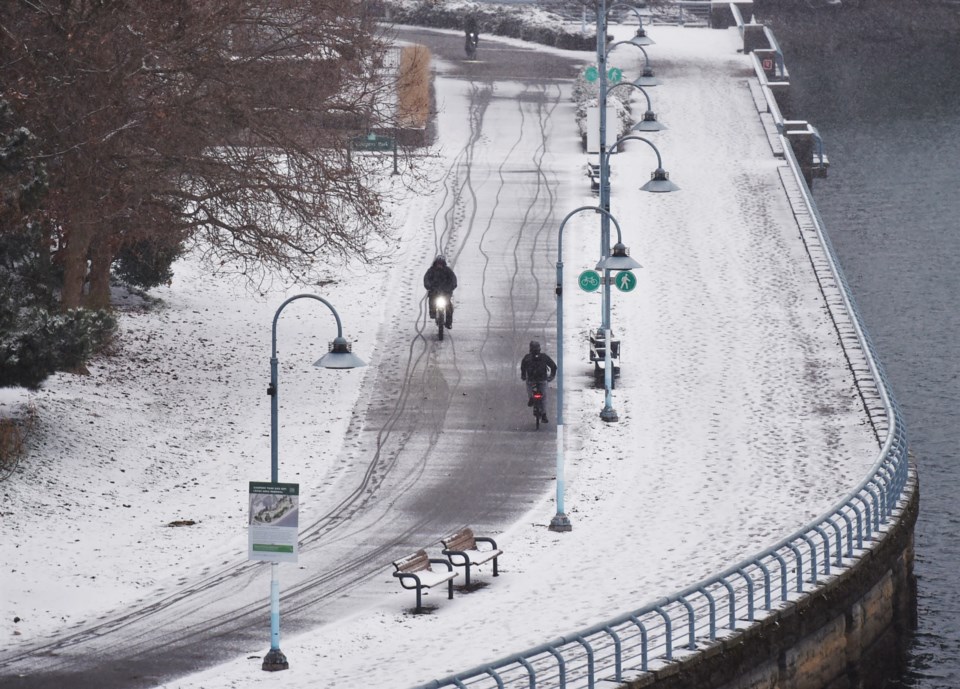While people outside of Canada might consider Vancouver a snowy city, simply because it's a Canadian city, most inside the country know winter on the south west coast has a different trend, usually.
So far, the snowy season has been more prominent in 2022, with one of the earliest snowfalls in the city's history starting things off, followed by a couple inches of snow that snarled traffic across Metro Vancouver on Nov. 29.
Even with the snowy start, Vancouver is nowhere near its snowiest year ever, when nearly 8 feet of snow fell in 1971.
And here are five other facts you probably don't know about winter in Vancouver.
1. The coldest day ever dropped to -18 C
While many major Canadian cities see temperatures in the -20s at least once a year, in Vancouver that's never happened.
The coldest day recorded for the city was Dec. 29, 1968, when temperatures dropped to -18 C. At the time there was an official weather station at UBC, which saw -18.3 C. At the airport, which is still being used as a weather station for the city, it hit -17.8 C.
The coldest day in Metro Vancouver was different, though, when a station in Pitt Meadows bottomed out at -23.3 C.
In 1950 -17.8 C was also reached in Vancouver.
2. The snowiest day ever saw more than a foot fall over 24 hours
In 1935 Vancouver was pushing through those late January blues when 44.2 cm of snow dropped on the city in 24 hours. That's about 17.5 inches.
It froze the city, as it wasn't prepared for such a huge storm. It even resulted in the collapse of the roof of the Hastings Park Forum hockey arena.
For those wondering if the Blizzard of 1996 came close, it did. Dec. 29, 1996 saw 40.9 cm, the second snowiest day in the city's recorded history.
3. Vancouver has a nine per cent chance of a white Christmas
Vancouver's not a very snowy city, generally, and while some Canadian cities always have a white Christmas (that's a Dec. 25 with at least 2 cm of snow on the ground), Environment Canada puts Vancouver as one of the least likely places in the country for such a day.
Using decades of data, they figure the chance we'll see the city blanketed in snow Christmas morning as nine per cent.
Last year some snow fell, but it didn't meet the threshold. The last time Vancouver had a proper white Christmas was 2008, so the city is about due.
4. There was a year where Vancouver saw almost no snow
It was actually quite recently, too. In 2015 almost no snow fell in Vancouver (or, at the airport, at least). Only trace amounts were measured on Dec. 17, meaning it was observed falling, but there was an "unmeasurable or insignificant quantity."
5. Vancouver's snow removal budget is tiny compared to other cities
Vancouver isn't usually very snowy, and the city's budget for dealing with it is not very big, compared to other Canadian cities.
In a report from last year City of Vancouver staff noted there are only about nine snowfall days, and 100 with icy conditions. In the four years previous, the average budget to deal with all that was about $5.4 million, with $3.6 million going to the actual response (the rest was for preparation work).
Montreal's is exponentially bigger, with around $170 million spent each year, or about 3 per cent of the city's budget. It's one of the biggest municipal snow-clearing operations in the world and even has its own Wikipedia page.
Montreal is the giant, and cities like Toronto ($90 million), Edmonton ($60 million) and Calgary ($40 million) sit in between. Vancouver's budget is actually not far off smaller B.C. cities, with Prince George nearing $10 million, and Kelowna and Kamloops both above $2 million. Victoria, as of a few years ago, had $36,000 put aside for snow events (though also had a $1 million contingency fund for weather events like snow).




